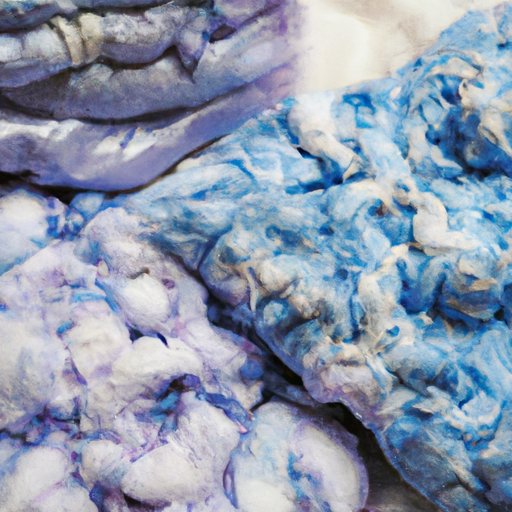Exploring the World of Indigo: A Look at the Significance, Uses, and Mysteries of the Color
Indigo, a blue-purple color, has captured the human imagination for centuries. From ancient cultures to modern times, indigo has been used for a variety of purposes, including dyeing fabrics, painting, and healing. In this article, we will explore the significance and uses of indigo throughout history, how it became a staple in the fashion industry, the process of making indigo dye, its mysterious healing properties, and the beliefs behind the existence of “Indigo Children.”
The Significance of Indigo Throughout History
Indigo has a rich history in cultures across the world. The oldest known evidence of indigo dye comes from Peru, where blue-dyed cotton fabrics have been found dating back to 6200 BCE. Indigo was also used in ancient Egypt, Greece, Rome, and China. It was prized for its deep, rich color, and was often associated with royalty and wealth.
Indigo played a significant role in trade and commerce, particularly in the 15th and 16th centuries. The European colonization of the Americas led to the mass production and exportation of indigo from countries like Haiti and Jamaica. Indigo was highly valued as a colorant for textiles, making it a profitable commodity for colonizers.
Indigo has also been used for artistic and spiritual purposes. It was a popular pigment for painting in the Renaissance period, and has been used to create religious art in various cultures. Indigo is also often associated with the third eye chakra in spirituality, associated with intuition and higher consciousness.
Indigo: The Mysterious Dye that Changed the Fashion Industry
Indigo’s popularity as a dye began in India, where a method of dyeing cotton with indigo was developed over 4,000 years ago. The process, called “vat dyeing,” involved fermenting indigo leaves to create a concentrated pigment that could be used to dye fabric.
Indigo skyrocketed in popularity in Europe during the 18th century, when it became known as “blue gold.” The blue denim fabric that we know today owes its existence to indigo, as it became the standard dye for jeans fabric in the 19th century.
Today, indigo remains a popular dye for denim, but is also used in other fashion fabrics, as well as in home decor. Its deep, rich hue makes it a sought-after color for many designers and consumers.
Understanding Indigo: From Plant to Pigment
The process of making indigo dye is complex, involving the breakdown of certain compounds in the indigo plant. The leaves are harvested, fermented, and then dried to create a powder. This powder is then mixed with water, lime, and other ingredients to create a dye solution. Fabric is then immersed in this solution and left to dry, resulting in a deep blue color.
What makes indigo so unique is its chemical properties. Indigo is an organic compound that, when exposed to oxygen, forms a blue color. Unlike other dyes, indigo does not dissolve in water, making it resistant to fading and washing out.
There are two types of indigo dye: natural and synthetic. Natural indigo is made from the indigo plant, while synthetic indigo is made using a chemical process. Synthetic indigo is more commonly used in the fashion industry today, due to its affordability and consistency.
The Healing Properties of Indigo: A Holistic Approach
Indigo has been used for its medicinal properties for centuries. Ancient Ayurvedic medicine used indigo to treat a variety of ailments, including liver and digestive issues, as well as chronic pain. In modern holistic medicine, indigo is still used, though in a less concentrated form.
The color indigo is associated with the third eye chakra, and is thought to promote intuition and spiritual awareness. Indigo is also used in color therapy to treat insomnia, anxiety, and other emotional imbalances.
Indigo is believed to have antibacterial and anti-inflammatory properties when used topically. It is often used in natural skincare products to treat acne, eczema, and other skin irritations.
Indigo Children: Separating Fact from Fiction
Indigo children are a controversial topic in spirituality and New Age circles. The term was first used in the 1970s to describe children with a supposed psychic ability. Indigo children are said to possess advanced intellect and creativity, as well as a strong sense of justice and empathy.
While there is no scientific evidence to support the existence of indigo children, many believe that they are a new generation of humans with a unique spiritual purpose. Some scientists attribute the supposed characteristics of indigo children to increased awareness of ADHD and other conditions.
Conclusion
Indigo is a color with a rich history and many uses. From dyeing fabrics to promoting spiritual awareness, indigo has left an indelible mark on human culture. While much of its mystery remains unsolved, the vibrancy and versatility of indigo continue to captivate people around the world.
If you’re interested in learning more about the uses and significance of indigo, there are many resources available, including books, documentaries, and classes on how to make indigo dye.
